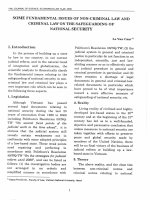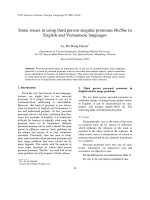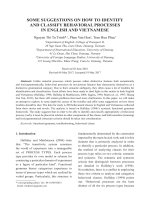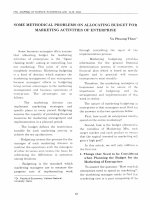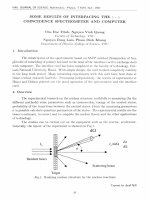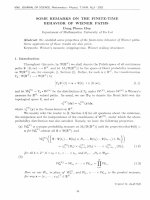DSpace at VNU: Some kinds of network and weak base
Bạn đang xem bản rút gọn của tài liệu. Xem và tải ngay bản đầy đủ của tài liệu tại đây (254.06 KB, 6 trang )
V N U JO U R N A L OF SCIENCE, M athem atics - Physics. T . x x , N 0 1 - 2004
SOME KINDS OF NETW ORK AN D W EA K BASE
Tran Van A n
Department o f Mathematics, Vinh University
A b s t r a c t In this paper, we study some kinds of network, and investigate relations be
tween the kinds of network and the point-countable weak base. It is showed that, if a
space has a point-countable /c7Vnetwork (strong-/^-network), then so is its closed compactcovering image.
1. I n tr o d u c tio n
Since D. Burke , E. Michael, G. Gruenhage and Y. Tanaka established the fundamer.tal theory on point-countable covers in generalized metric spaces, many topologists
have discussed the point-countable covers with various characters. Then, the conceptions
of /t'-network, weak base, cs-network, cs*-network, wcs*-network . . . were introduced. The
stucy on relations among certain point-countable covers has become one of the most im
portant subjects in general topology. In this paper we shall study some kinds of network,
consider relations among certain networks and prove a closed compact-covering mapping
theorem 011 spaces with a point-countable kn-network or strong-/c-network.
We adopt the convention that all spaces are Ti, and all mappings are continuous
and surjective. We begin with some basic definitions.
1 . 1 . D e fin itio n . Let X be a space, A c X . A collection T of X is called a full
cover of A if T is a finite and each F G T , there is a closed set C( F) in X with C(F) c F
such that A c \ J{C(F) ' F e T } .
1.2. D e fin itio n . Let X be a space, and V be a cover of X .
( 1 ) V is a k-network if, whenever K c u with K compact and u open in X . then
K c
c Ư for some finite T c V.
(2) V is a network if for every X e X and u open in X such that X € u . then
X € U T c u for some finite T c V.
(3) V is a strong-k-network if, whenever K c u with K compact and u open in
X . then there is a full cover T c V of K such that u T c u .
(4 ) V is a kn-network if, whenever K c u with K compact and u open in X.
then K c (yjT)° c UJF c u for some finite T c V.
(5) V is a cs-network if, whenever {xn } is a sequence converging to a point X E X
and u is an open neighborhood of X , then {x} u {Xm : m > k} c p c u for some k e IN
and some p E V.
(6 ) V is a cs*-network if, whenever {xn } is a sequence converging to a point
X € X and u is an open neighborhood of X, then {x} u { x ni : i e w } c p c u for some
subsequence { x JLi} of { x n } and some p G V.
T y p e s e t by
1
T ra n V a n A n
2
(7)
V is a wcs*-network if, whenever {xn } is a sequence converging to a point
X £ X and u is an open neighborhood of X, then { x nị : i E -fV} c p c u for some
subsequence {xn i} of {xn } and some p e V .
The following character of kn-network will be used in some next proofs.
1.3. P r o p o s itio n . For any space, the following statements are equivalent
(a)
(b)
V is kn-network;
For every x G l and any open neighborhood u of X, there is a finite subcol-
lectior. T o f v such that X
£ (LLT7)0 c UJF c
u.
proof. The necessity is trivial.
We only need to prove the sufficiency. Let K be a compact subset of X and u an
open set in X such that K c u . For every X € K . there exists a finite subcollection
c V such th a t X e (yjTx)0 c UFx c u . T hen the collection { ( u f x)° : X e K }
covers K . Because K is compact, there are the points X i, . . . , Xk in K such that the finite
subco’lection { ( u ^ r )° \ i — 1 ,... , k} covers K . Denote
F = { F : F e T Xi, < = 1....... A:>.
Then, the finite subcollection T satisfies
n
K
c ỊJ(U^>)° c (u^)° CUT c u .
i= 1
1.4. D e fin itio n . For a space X and X £ p c X , p is a sequential neighborhood at
c inX if, whenever {xn } is sequence converging to X in X, then there is an m G ÍV such
that \Xn : n > m} c P.
For a collection of subsets T of a space X , we write
Int 5(Jr) = {x G I : UJ 7 is a sequential neighborhood at x ).
A cover V of X is called is a ksn-network if, whenever X E u with X E X and u
open in X , then X G Int^Li.?7) c yjT c u for some finite T c v .
1.5. D e fin itio n . Let X be a space, aT d p = u { v x
G X} be a family of subsets
ofX which satisfies th at for each 2 E X,
(1) X £ p for all p G P x;
(2 ) If [/, V £ Vx, then w c u n v for some w e V x .
? is called a weak base for X iff a subset c of X is open in X if and
only if for
X £ c there exists p € v x such that p c G.
1.6 . D e fin itio n . Let X be a space, a cover V of X is called point-countable if for
ever. T G l , th e set { P G V : X e p } is a t m ost countable.
each
Some kinds of network and weak base
3
We have the following diagram
cs-network=> cs*-network <=strong-fc-network
weak base =>wcs*-netw orks
/c-network
ft
k sn -network <=
kn-network.
It is well known from [10] th at weak base => cs-network => cs*-network => wcs*network fc-network =>■ wcs*-network. From the'above definitions, it is easily to jrcve that
strong-/c-network => k-network, k n -network => fc-network, k n -network => fcsrj-network,
and k s n -netw ork =>• VJCS*-network.
In this paper we shall provide some partial answers to connections betwea kinds
of network and weak base.
2. M ain results
The following lemma is due to [5].
2.1. L e m m a . Let V be a point-countable cs-network for a space X . If 3 e K n u
with u open and K compact, first countable in X . then X e Inth-ỊP n K ) c I c u jor
some p € V ■
First we present some connections between kinds of network
2.2. P r o p o s itio n . For any space, if V is a strong-k-network, then V i: a a* network.
Proof.
Let V be a strong fc-network, a sequence converging {x„} to a poilt X a X
and all open neighborhood Ư of X , then there is a full cover T c V of conpict sets
{x} u {Xji : n > 1} such th at U T c u . From the definition of a full cover, it folcws -,hit
there exist a p e T and a subsequence {x„t } of {x„} such th a t {x} u { x n i } C P so tlis
shows th at V is a cs*-network.
2.3. P r o p o s it i o n . Let X be a locally compact, first countable space. Ij V is a
point-countable cs-network for X , then T* is Ũ point-countable ksn-network.
Proof. Let V be a point-countable cs-network. For every X e X and any open neijhtorhoid
u of X since X is locally compact, there is a compact neighborhood K of
By tie
first countability of X it follows from Lemma 2.1 that there exists p € V sich that
X 6 In t k ( P C \ K ) c p c u . Now, let { x n } be an any sequence coverging to X. ie:auteK
is a neighborhood of X and In tk (KC\P) is neighborhood of X in K , there is an m e IN su;h
that {x} u { x n : n > m ) c In tk { K n p ) c p c u . This implies th at X € Int(?) c p.
Thus, V is a ksn-network.
2.4. P r o p o s itio n . Let X be first countable. I f V is a point-count able .s-netvirk
fo r X , then V IS a k-network.
Proof. Let V be a point-countable cs-network. Let K be a compact subset aid I in
open subset of X such th at K c u . For every X 6 K , it follows from Lemna2.1 tlat
Fran Van An
4
X E Intic(K n p x) c p x c u for some p x 6 p .
m
,x m in K so th at K c
By compactness of K there exist
771
nPr ) c
i= l
Px c u . Thus, p is a pointi=l
countable /c-network.
Now we shall give some partial answers to the inversion of above implications
2.5. T h e o r e m . Let X be first countable. Then, V is a point-countable ksn-network
for X if and only if V is a kn-network.
Proof. The sufficiency is obvious.
We only need to prove the necessity. Let V be a ksn -network for X . For every
X £ X and any open set u in X such that X € Ư, there exists a finite subcollection
T c V satisfying X £ Ints( u j r) c U T c u . By {Gn } we denote the countable base of
neighborhoods of X such that G n+ 1 c Gn for all n G IN. Then there is an m G IN so
that Gm c u ^ 7. Otherwise, for every n E w there exists an £n E Gn \ (u^7). It is easily
seen that the obtained sequence {xn } converges to X but x n Ệ u T for all n G IN. This is
contrary to X G Ints( u ^ ) . Hence, X G (u ^ 7)0 c yjT c Ư. It follows from Proposition 1.3
th a t V is a k n - network.
It follows immediately from the proof of Theorem 2.5 that
2.6. C o ro lla ry . Let X be first countable. If V is a point-countable ksn-network
for X , then V is a k-network.
2.7. T h e o r e m . A space X is the first countable if only if X has a point-countable
kn-network.
Proof. Let X be first countable. For every X G X by v x the base of open neighborhoods
of X. Let V — UVX. Then V is a point-countable weak base.
Conversely, let V — UVX be a point-countable kn-network. For every X G X , let
v x = { p € V : X G p } and
Bx = {(UJ 7)0 : T is finite, T D v x
2.8. T h e o r e m . Let X be first countable. ■Then X has a point-countable wcs*network for X if and only if it has a point-countable weak base.
Proof. The ”if” part holds by the above diagram, so we prove the ’’only if’ part. Without
loss of generality we may assume th at V is a point-countable w cs*-network for X which
is closed under finite intersections. For every X E X by Qx = {Qn{x) •' rc £ IN} we denote
the countable base of neighborhoods of X such that Qn_|_i(x) c Qn{x) for all n £ JFV, and
put Vx = { P É V • Qn{x) c p for some n G -ÍV}. Then, p is a neighborhood of X for each
P G ? X. N ow we show th a t Ổ = UPx is a point-countable weak base.
It is easily seen th at for each X E X , v x is point-countable, and if P\ € V x , P 2 € Vx ,
then we have P\ n P 2 € V X. Now we prove that a subset G of X is open in X if and only
if for each X G G, there exists p e V x such th at p c G.
In fact, let G be an open subset of X , X any element of G, and { p
G} = {Pm(x) : m 6 iV}. Assume the contrary th at Qn(x) <Ị_ Pm{x) for each n , m € IV.
Some kinds of network and weak base
5
Then, take x n m É Qn{x) \Pm( x) for every n, m e IN. Now for n > m we choose yk = £n,m,
where fc = m + n--2='- ^. Then the sequence {yk} converges to the point X. Thus, there exist
a subsequence {y/c,} of {yk}, and 771, 2 G w such that {y/c, : fcs > z} c p m(x) c G. Take
k s > i with yk = x nTn for some n > 771. Then £n m £ Pm(x). This is a contradiction.
Conversely, if ơ c X satisfies the following condition: for each X e G there exists
p € *px w ith p c G. T hen, since p is a neighborhood of X for each p G
G is a
neighborhood of X. Thus, G is open in X. Hence B = UVX is a point-countable weak base
for X .
Finally, it is well known that spaces with a point-countable cs-network, cs*-network,
or closed k-network are not necessarily preserved by closed maps (even if the domains are
locally compact metric). But, spaces with a point-countable k-network are preserved by
perfect maps [4]. In the remain part we give some properties of closed compact-covering
maps.
The following lemma in [1] shall be used in the proof of Thoerem 2.12
2.9. L e m m a . If V is a point-countable cover of a set X , then every A c X has
only countably many minimal finite covers by elements o f V.
2.10. D e fin itio n . A mapping / : X —> Y is compact-covering if every compact
K c Y is the image of some compact c c X .
A mapping / : X -» Y is perfect if X is a Hausdorff space, / is a closed mapping
and all fibers
are com pact subsets of X .
2 . 1 1 . P r o p o s i t i o n .([3]) I f f : X -» Y is a perfect mapping, then for every compact
subset z c Y the inverse image f ~ l (Z) is compact.
2.12. P r o p o s itio n . Every a perfect map is compact-covering.
Proof. It follows directly from their definitions and Proposition 2.10.
2.13. T h e o r e m .
Let f : X —►Y be closed, compact-covering. If X has a
point-countable kn-network (strong-k-network), then so does Y respectively.
Proof. Assume V is a point-countable kn-network for X . Let $ be the family of all finite
subcollections of V. For T €
let
= {y e Y : T is a minim al cover of f ~ l (y)}
and let V ' = ( M ( ^ ) : T G $}. It follows from Lemma 2.8 that V ' is a point-countable
collection of subsets of y . Let us now show th at V is a kn-network. Let K be compact
in Y and u an open subset of Y such that K c u . As / is compact-covering, there exists
a compact set c c X such th at f ( C ) = K. By continuity of f we obtain an open set
f ~ l {U) in X and c c
Then, there exists a finite subcollection T c V such that
c c ( u r r c U T c r l (U). Let T ' — {M(£) : £ c T ) , then T ' is a finite subcollection
of V ' and u p = u [u e Y : f ~ l {u) c u J7} c u . If w = Y \ f [ X \ (u?7)0], then, because
/ is closed, it follows th at w is open in y , and K c (UJF7)0 c
c u and therefore the
theorem is proved.
Tran Van An
6
The proof of the Theorem in the case X having a strong-/c-network is similar.
From Theorem 2.12, Proposition 1.3 and Proposition 2.11, it follows that
2.14.
C o ro llary . Let f : X —)• Y be a perfect map. I f X has a point-countable
kn-network (strong-k-network), then so does Y respectively.
R e feren c e s
1. D. Burke and E. Michael, On certain point-countable covers, Pacific Jounal of
Math. 64, 1(1976), 79 - 9Ồ.
2. H. Chen, Compact-covering maps and fc-networks, Preprint,(2003).
3. R. Engelking, General topology, Warzawa 1977.
4. G. Gruenhage, E. Michael and Y. Tanaka, Spaces determined by point-countable
covers, Pacific Jounal of Math. 113, 2(1984), 303 - 332.
5. S. Lin and c . Liu, On spaces with point-countable cs-networks, Topology Appl.,
74(1996), 51 - 60.
6 . S. Lin and Y. Tanaka, Point-countable k-networks, closed maps, and related
results, Topology AppL, 59(1994), 79 - 86 .
7. A. Miscenko, Spaces with a pointwise denumerable basis, Dokl, Akad, Nauk S S S R ,
145(1962), 985 - 988.
8 . Y. Tanaka, Theory of k -networks II, Q and A in General Topology, 19(2001), 27
- 46.
9. Tran Van An, On some properties of closed maps, Preprint, (2002).
10. P. Yan and s. Lin, Point-countable k-networks, cs*-networks and a 4-spaces, Topol
ogy P r o c 24(1999), 345 - 354.
